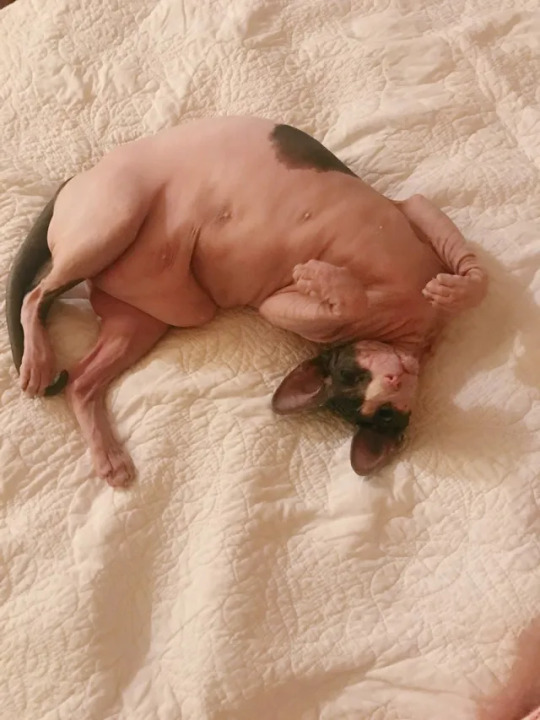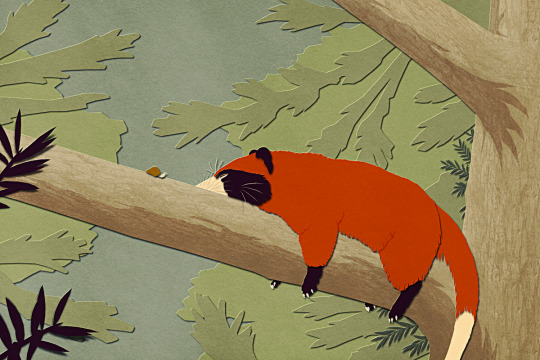#placental mammals
Text
pt II australia but i've never been there
I didn't even have to wait for y'all's responses on part I to make this because Australia is WILDING. As per usual, salutations to Arthur's grandmother's boyfriend Brian.
Everything remaining that I know about Australia:
There was an emu war. There were many emu casualties, and no human ones, but the emus won anyway. Sun Tzu is making way for the emus.
That was the only research I did on the emu wars, but as someone who met a few emus once, they were very lovely to me and very soft to pet. They also were very jabby. One of them looked deeply concerned as they looked at me, I believe they thought I was a deformed emu. I am on the winning side of the war.
During Christmas, Santa does not have a sleigh. He has a surfboard, and he does slay.
There are a lot of animals. Many have no placenta, as I recall from biology. Due to the nature of the continental drift and geographical isolation, Australian marsupials evolved separately from placental mammals, and were not wiped out by invading species. Due to convergent evolution, there are also analogous species between the placental mammals and the marsupials.
What just happened I'm sorry deep science trauma was unearthed. The point is, a lot of animals. A kangaroo is probably in your backyard. A koala just stole your girlfriend. An alligator murdered your classmate. It just happens.
KOOKOOBURRA SITTING ON THE OLD GUM TREE MERRY MERRY SOMETHING SOMETHING idk I was 3 when my mum sang me that.
The internet is awful. Rumours are that the local snake ate it.
Australia is very very pretty, I know this because of an Australian Tourism Department ad that I saw when I was 12 and had cable TV.
You must not forget your Hat. It's like the three little kittens song, but with the Hat instead of mittens.
The Wibbles are a thing. I thought they were a band. Spotify said no. I no longer know what they are.
Crocodile Dundee is a thing. I saw him in Snoopy/Peanuts.
Steve Irvin met his wife in an animal area and his daughter met her husband in an animal area. I don't know anything more these lovely folks, or what the animal area was, I'm afraid.
There is a cake with white stripes that is the Best for Birthdays.
The accent is beautiful, but I admit for years I couldn't differentiate it from British and American accents as a child because to me it sounded like the lovechild of them both and it made me very confused.
Uh, Australia exists.
Yeah, no, that's all I've got. Love to the Australian maggots.
#good omens mascot#now in the uh#Australian fandom#australia#australia memes#australia funny#ig idk#crocodile dundee#steve irwin#wibbles#australian accent#biology#convergent evolution#placental mammals#marsupials#emu war#emus#i don't know#how do i tag this#IDK#maggots#mascot#weirdly specific but ok#asmi
192 notes
·
View notes
Text
If you think there are at least some non-animal organisms, like archaea or fungi or all opisthokonts plants, that meet the stated criteria, select the first option ("Animals or other.") We're discussing terrestrial, biological life only, though, so extraterrestrial life, supernatural beings, or machine intelligences do not figure in to this scheme (but feel free to discuss them in the notes).
Eumetazoa is, AFAICT, the largest group of animals that includes all animals with at least some nervous tissue--so not sea sponges. But it does include a few clades without nervous systems, like the Placozoa.
Chordates are all animals containing a dorsal nerve cord specifically: chordates do not include, e.g., insects, molluscs (including octopuses and squid), and starfish. Chordates do include all fish.
Tetrapods include all animals with four limbs and distinct digits; this excludes most, but not all fish, and includes reptiles, mammals, dinosaurs (including birds), and amphibians.
Mammals includes all animals that nurse their young, have fur, have a neocortex, and have three middle ear bones. This group includes monotremes like the platypus, as well as more familiar animals like dogs, cats, cows, horses, mooses, and more(ses).
Primates includes monkeys, lemurs, apes, tarsiers, lorises and, of course, humans (though all of these clades include humans).
Hominids include gorillas, orangutans, chimpanzees, and humans ("apes").
Hominins includes just humans and chimpanzees (including bonobos). (I think; the taxonomic nomenclature distinguishes between Hominidae, Hominini, Homininae, Hominina, and Hominoidae, so I might have mixed some of these up. Blame the ICZN or whoever is responsible for this mess.)
Australopithecines (equivalent to "Hominina," I think, but don't quote me on that) includes all extinct hominins more closely related to humans than to any other extant species, like Australopithecus africanus, Paranthropus robustus, and of course later species like Neanderthals and Homo sapiens.
Homo is the genus that includes the whole human family in the broad sense: modern humans, Neanderthals, Denisovans, Homo erectus, and Homo habilis.
Homo sapiens includes only anatomically modern humans, as we emerged around 300,000 years ago in Africa.
#i really wanted like four or five more options#to make this poll with sufficient granularity#oh well#pretend eukaryotes bilateria vertebrates and placental mammals are also on the list#and possibly synapsids and the eukaryotes+archaea group just for fun
66 notes
·
View notes
Text


#Black-and-white ruffed lemur#Varecia variegata#Ruffed lemur#Varecia#lemur#primate#placental#mammal#animal#zoology#zoology meme#Zoo#shitpost#meme#conservation#metazoa
76 notes
·
View notes
Note
So you said that what makes a mammal is the descendant of the most recent common ancestor of a platypus and a mouse.
Does that mean platypi are some of the oldest mammals?
Noooooooo no, it means the platypus/monotremes in general diverged from other mammals first. but the lineage that lead to monotremes and the lineage that lead to therians evolved at the same time, because they diverged at the same time.
-- Mammals ---- Monotremes (Echidna & Platypus)
|
Therians ---- Marsupials
|
Placental Mammals
I'd go into how placental mammals are divided, but honestly I'm not a synapsid researcher and Idk where the interrelationships of Boreoeutheres, Afrotheres, and Xenarthrans are at this point. @synapsid-taxonomy?
42 notes
·
View notes
Text
Wondering if I can get away with non-placental ungulates or if I'll have to do some wacky co-evolution bullshit with the large hairy beasts of Paiga
#worldbuilding#the gerbali are native to the continents encompassing paiga (not the ones placental mammals/humans came from) and like#how am I gonna get a pouch on a kudu/proto-giraffe
11 notes
·
View notes
Text
It still amuses me that whales and dolphins are technically the smartest living hoofed mammals
#of course if you don't count them that title would go to pigs and goats i'm pretty sure#i keep feeling like elephants should be ungulates but alas they're from an entirely different line of placental mammals#cetaceans
33 notes
·
View notes
Text
🐫 Animal #113 🐾
I figured it out in 5 guesses!
🟥🟥🟥🟥🟩
🔥 7 | Avg. Guesses: 6.8
there's always that one member of a clade that just lives in a blind spot and you guess every other member of the clade for five minutes before you remember it.
#metazooa#metazooa 113#5 guesses is about my average guess--i don't know how you could speed it up much past that outside of lucky first guesses#neognathae always throws a wrench in the average bc you're stuck taking potshots like#is it a fowl? is it a raptor? is it a dove? is it a songbird? is it a parrot? no! it's a falcon!#and none of the answers tell you anything but ''not that one''#same with fish#it branches too much too soon so you can't half-split the clade very easily.#they need to take lessons from mammals--those split nicely in ways that make it easy to make useful guesses#my first guess is always armadillo and then i do further standard guesses from there based on result#placental mammal: wolf#amniote: crocodile#bony fish: yell a profanity then guess tuna
3 notes
·
View notes
Text
i just remembered that time we all did some Science to try and figure out what kind of animal mahjarrat are and we settled on "placental non-mammal" because a) zamorak has a bellybutton and b) mahjarrat don't eat
#the ''non-mammal'' bit is just straight canon no matter how much jagex tries to pretend otherwise lmao#but they can't even agree on the placental part these days :T#runescape
4 notes
·
View notes
Text
apparently they only have three native lizards in the uk… that’s insane. i can see three different species of lizard 🦎 on the average glance out my window
#i had to google this because i was genuinely not sure if there were any#and i was like well no that’s ridiculous. of course they have lizards in england.#and then i was like. wait. ARE there?#anyway the uk doesn’t really do reptiles. australia doesn’t really do placental mammals. we’ve all got our little things going on.
4 notes
·
View notes
Text
spent a stupid amount of time while watching the first season looking for evidence for or against the evolution of any more derived vertebrates than amphibians in amphibia, until watching the intro for like the sixth time and realizing there’s literally a giant lizard and bird in it
#my posts#amphibia#wasn't sure if the snake thing from like the first episode was actually a fish#i did hold out on mammals but there are in fact some possum looking things at one point that are probably real mammals#don't recall seeing any placental mammals but my initial thesis of 'vertebrates stopped diverging with amphibians in amphibia' is dead#killapillars are insects they don't count
4 notes
·
View notes
Text
youtube
Tierzoo is making Death Battle with prehistoric creatures, I can't see this backfiring at all!
#paleoblr#can I get an accuracy check?#awesomebro#paleontology#video#Tierzoo#Utahraptor being the same weight as Smilodon doesn't seem right to me...#Apparently Awesomebro is in Urban dictionary and Know Your Meme. Good job guys!#Utahraptor#Smilodon#cats#carnivora#placentals#mammals#dromeosaur#raptor#theropod#dinosaur#animalia#animation#palaeontology#prehistory#death battle#awesome bro#awesomebro bait#youtube#Youtube
7 notes
·
View notes
Text
If you've seen trivia posts going around, may have seen ones about the baculum, a bone in the penis whose purpose is to help support erections which is present in most placental mammals, including non-human apes, but which is conspicuously absent in humans.
Those posts typically don't go into why this is the case, which is fair enough, since the question is far from settled. However, there are a lot of hypotheses about it, and some of them are pretty fucking wild.
I think my personal favourite is the recently proposed idea that, since soft tissue injuries tend to heal more rapidly and completely than broken bones, a flexible and resilient boneless penis constitutes a reproductive advantage in situations where genital trauma is common, possibly as a result of the development of upright posture rendering the penis more prone to blunt encounters.
Like, imagine humanity's proto-hominid ancestors going "actually, bipedalism is great" and promptly getting whacked in the ding so much that it exerted evolutionary pressure on the morphology of the penis.
#science#biology#evolution#history#penis mention#violence mention#injury mention#genital trauma mention#swearing
18K notes
·
View notes
Note
Why do men have nipples?
it's not just human men, it's all placental mammals!

pour one out for all of the "I found this weird lump on my male cat's chest, what is it" posts on r/cats
the short answer is: because it's easier.
so, natural selection is lazy. it tends to take the quickest and easiest path to any given solution and can only work with what it already has, so it's really reluctant to drop traits that aren't actually hurting anything by being around! like male nipples.

and since male and female mammals in general start as the same weird little flesh tadpole thing and only start to diverge a couple months into development, it's waaaay easier to just leave male mammals with mostly non-functional nipples than it is to patch them out and maybe bork up something with the female nipples by mistake.
tldr: it's because evolution is naturally lazy.
2K notes
·
View notes
Text

Although most Mesozoic mammals were rather small, a few different lineages produced some pretty hefty-sized forms – most notably the metatherian Didelphodon, the gondwantherians Adalatherium and Vintana, and the eutriconodont Repenomamus.
And now we've got another one to add to that list.
Patagomaia chainko lived towards the end of the Cretaceous, about 70 million years ago, in what is now Patagonia near the southern tip of South America. Known from some partial leg and hip bones, it was potentially the largest known Mesozoic mammal yet discovered – estimated to have been similar in size to a modern bobcat, roughly 50cm tall at the shoulder (~1'8") and weighing around 14kg (~31lbs).
Distinctive anatomical features of the bones indicate it was an early therian mammal, the group that contains both modern marsupials and placentals, but it can't currently be classified any more specifically than that. Mesozoic therian fossils are very rare in the southern continents, so Patagomaia's presence in late Cretaceous South America adds to their known range and diversity, as well as providing an example of surprisingly large body size for the time.
Without more material it's impossible to tell what Patagomaia's ecology was. I've gone for a fairly generic life appearance here, and while what's known of its joints and muscle attachments doesn't indicate climbing specializations, plenty of unexpected tetrapods still like to get up on tree branches.
———
NixIllustration.com | Tumblr | Patreon
#science illustration#paleontology#paleoart#palaeoblr#patagomaia#theria#mammal#mesozoic mammal#art#big mesozoic mama#truly one of the most mammals of all time
336 notes
·
View notes
Text
Man, Robert Kaleski really is a great counterexample to that whole "the lone autistic eccentric, immersed in his dogged study and obsessions, is the genesis of truth!" trope that you'll sometimes see "aspie supremacists" trot out as part of a justification that autistic (or ADHD) people are Better, Actually.
My good bitches, sometimes what happens is simply that dogged pursuit of one's own pet theories blinds us to the truth of corroborated sources, experimental evidence, and hypothesis testing.
Just because someone is autistic and fixated on a special interest doesn't mean they're right about it. Sure, you can see how someone might look at Dalmatians and cattle dogs and come to a conclusion that some of one might have influenced the other. I reckon that by the 1930s, when the first appearance of the Dalmatian lore appears, Kaleski had enough exposure to Dalmatians to know that they are all born white or almost white and develop the characteristic spots as they grow—just like his beloved heelers develop roan and speckles as they grow. Dalmatians are all almost certainly homozygous for a modifier mutation adjusting the expression of roan that is not found in cattle dogs, but Kaleski can be quite forgiven in the 1930s for not knowing that: the study in question only came out last year. However, he might easily have realized by inquiring to kennel clubs, a Dalmatian club or breeder in his country, or simply perusing various books of British dog breeds — a self admitted enormous pastime! — that his timeline of a dog breed standardized in 1890 being infused to any great degree into his familiar cattle dogs before he personally would have observed evidence of the cross in 1904, after nearly twenty years of studying cattle dogs, is impossible.
Unfortunately, despite his careful observation of things that he felt confirmed his theories about dog function and evolution, he failed to look for any facts that were difficult to reconcile with them. Scholarly study of natural history would immediately have poked holes in his frankly batshit bonkers theory that bears were descendants of Tasmanian devils while dogs and cats derive from thylacine. Miacis was discovered in 1872. Cuvier had famously and correctly identified marsupials as a parallel clade to placental mammals a full century before, in 1816. There was abundant information available to Kaleski with which to test his theories about natural history and the known consensus of the evolution of his local Australian fauna.
Special interests encourage us to absorb, collect, and integrate information that might not strike a neurotypical person as interesting. But there is absolutely nothing about that interest which protects us from collecting and absorbing incorrect ideas, connections, and justifications as we amass our hoards of knowledge. We have to test our own assumptions, every step of the way.
280 notes
·
View notes
Text

I’ve got good news for you! The rabies virus evolved to affect warm-blooded animals and requires temperatures around 36°C to 38°C (97°F to 100°F) to thrive. Which is the body temperature of your average placental mammal. Marsupials, however, have average body temperatures in the range of 35°C (95°F) and monotremes even lower, at 31°C (87°F)!
This means that marsupials (even your average virginia opossum) are too cool to get rabies. Literally! It’s not impossible for them to get infected with it and there have been documented cases, but it’s very, very rare. Not only that, but also since most mammals in Australia are marsupials and monotremes, the rabies virus is considered practically inexistent over there! So the Australian possums from that post have zero chances of giving you rabies. Being placental mammals, it’s much more likely that a colugo would get infected with it, but by what I’ve been able to gather from some cursory research, it’s not common for them to be exposed to the virus. I haven’t been able to find a single documented instance.
I’ve also got some bad news, though: you still can’t hold them because they’re wild and have teeth and claws. 😔 None of these animals grow very large but as someone who has been badly bitten by a very angry rat once, small animals ≠ painless bites.
#In case anyone’s wondering the rat bit me because her owner gave me her *newborn babies* to hold without warning#Her maternal instincts kicked in and she bit the shit out of one of my fingers. Her teeth fully pierced my fingernail.#It took a few days for it to stop hurting enough for me to actually use it again
123 notes
·
View notes